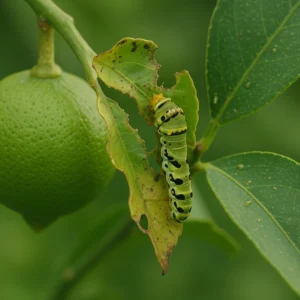Acid Lime Pests
Lemon Butterfly

Symptoms
Leaf Damage:
- Defoliation: Caterpillars feed on the leaves, causing severe defoliation, particularly in young plants. This can reduce the plant's ability to photosynthesize and ultimately stunt its growth.
- Leaf Skeletonization: In the early stages of infestation, caterpillars may skeletonize leaves, leaving behind the veins while consuming the softer tissue.
Reduced Plant Vigor:
- Young citrus plants are most vulnerable, and severe infestations can lead to reduced growth and delayed fruiting due to the loss of foliage.
Indirect Effects:
- While the lemon butterfly itself does not transmit diseases, the stress caused by heavy feeding can make citrus plants more susceptible to other pests and diseases
Identification
Adult Butterfly:
- Appearance: The adult lemon butterfly is medium-sized, with a wingspan of about 80-100 mm. It has a black body with white spots and wings that are predominantly black with yellow and orange spots. The forewings have irregular white and yellow patches, while the hindwings have a distinct red eyespot and a series of blue and orange markings near the edges.
- Behavior: Adult butterflies are often seen fluttering around citrus plants, especially during the day. They lay their eggs on the leaves of citrus plants.
Eggs:
- Appearance: Eggs are tiny, spherical, and pale yellow. They are usually laid singly on the upper surface of young leaves.
- Behavior: The eggs hatch within a few days into larvae (caterpillars).
Larvae (Caterpillars):
- Appearance: Lemon butterfly caterpillars go through several stages (instars) of development, each with a distinct appearance:
- Early Instars: Young caterpillars are small, black, and white with a bird-dropping mimicry pattern, which helps them avoid predators.
- Later Instars: As they mature, they become green with white diagonal stripes and an enlarged thoracic segment that gives the appearance of a snake's head. This mimicry helps deter predators.
- Behavior: Caterpillars feed voraciously on citrus leaves, often stripping young plants of their foliage entirely. They tend to feed on the edges of leaves and move towards the center as they grow.
- Appearance: Lemon butterfly caterpillars go through several stages (instars) of development, each with a distinct appearance:
Pupae (Chrysalises):
- Appearance: The pupae are green or brown, resembling a small piece of wood or a leaf stem, providing camouflage.
- Behavior: Pupation usually occurs on the citrus plant itself or nearby. The pupal stage lasts about 10-14 days, after which the adult butterfly emerges.
Management
- Natural Predators and Parasitoids: Encourage the presence of natural enemies such as parasitic wasps (e.g., Trichogramma spp.) that lay eggs in butterfly eggs or caterpillars. Predators like birds, spiders, and ants can also help control caterpillar populations.
- Bacillus thuringiensis (Bt): Bt is a naturally occurring bacterium that acts as a biological insecticide, effective against caterpillars. Spraying Bt on the foliage can target young larvae without harming beneficial insects or the environment.
|
Insecticide |
Dosage |
|---|---|
|
Bacillus Thuringiensis Var. Kurstaki Serotype 3a, 3b, Sa Ii WG |
1 gm/lit |
|
0.5 ml/lit |
|
|
1 ml/lit |
₹999
Select options
This product has multiple variants. The options may be chosen on the product page

